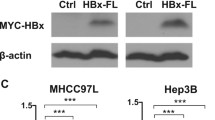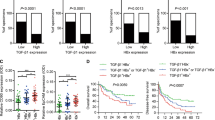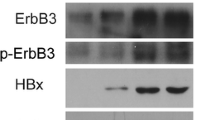Abstract
Hepatocellular carcinoma (HCC) is a common malignancy and a leading cause of cancer death worldwide. Hepatitis B x-interacting protein (HBXIP), a cofactor of survivin, was originally identified by binding with the C-terminus of the HBx and negatively regulated the activity of HBx. In this study, the effect of HBXIP on the hepatoma cells-induced angiogenesis was investigated. Proliferation and migration of human umbilical vein endothelial cells (HUVECs) were detected by MTT and transwell assay, respectively. Tube formation and chick chorioallantoic membrane model were used to observe the angiogenesis. Vascular endothelial growth factor activity was assayed using ELISA kits. Western blotting was performed to examine the protein expression. Our results indicated that overexpression of HBXIP increased HepG2 cell-induced endothelial cells migration, proliferation, and angiogenesis, which may be related to increasing phosphorylation of endothelial NO synthase in HUVECs. These results suggest that HBXIP may play an important role in tumorigenesis by enhancing angiogenesis in HCC.






Similar content being viewed by others
References
Yang JD, Roberts LR (2010) Hepatocellular carcinoma: a global view. Nat Rev Gastroenterol Hepatol 7(6):448–458. doi:10.1038/nrgastro.2010.100
Coulon S, Heindryckx F, Geerts A, Van Steenkiste C, Colle I, Van Vlierberghe H (2011) Angiogenesis in chronic liver disease and its complications. Liver Int 31(2):146–162. doi:10.1111/j.1478-3231.2010.02369.x
de Castro Junior G, Puglisi F, de Azambuja E, El Saghir NS, Awada A (2006) Angiogenesis and cancer: a cross-talk between basic science and clinical trials (the “do ut des” paradigm). Crit Rev Oncol Hematol 59(1):40–50. doi:10.1016/j.critrevonc.2006.02.007
Shojaei F, Zhong C, Wu X, Yu L, Ferrara N (2008) Role of myeloid cells in tumor angiogenesis and growth. Trends Cell Biol 18(8):372–378. doi:10.1016/j.tcb.2008.06.003
Melegari M, Scaglioni PP, Wands JR (1998) Cloning and characterization of a novel hepatitis B virus × binding protein that inhibits viral replication. J Virol 72(3):1737–1743
Marusawa H, Matsuzawa S, Welsh K, Zou H, Armstrong R, Tamm I, Reed JC (2003) HBXIP functions as a cofactor of survivin in apoptosis suppression. EMBO J 22(11):2729–2740. doi:10.1093/emboj/cdg263
Fujii R, Zhu C, Wen Y, Marusawa H, Bailly-Maitre B, Matsuzawa S, Zhang H, Kim Y, Bennett CF, Jiang W, Reed JC (2006) HBXIP, cellular target of hepatitis B virus oncoprotein, is a regulator of centrosome dynamics and cytokinesis. Cancer Res 66(18):9099–9107. doi:10.1158/0008-5472.CAN-06-1886
Wang FZ, Fei HR, Lian LH, Wang JM, Qiu YY (2011) Hepatitis B x-interacting protein induces HepG2 cell proliferation through activation of the phosphatidylinositol 3-kinase/Akt pathway. Exp Biol Med Maywood 236(1):62–69. doi:10.1258/ebm.2010.010179
Lamalice L, Le Boeuf F, Huot J (2007) Endothelial cell migration during angiogenesis. Circ Res 100(6):782–794. doi:10.1161/01.RES.0000259593.07661.1e
Tsai WL, Chung RT (2010) Viral hepatocarcinogenesis. Oncogene 29(16):2309–2324. doi:10.1038/onc.2010.36
Benhenda S, Cougot D, Buendia MA, Neuveut C (2009) Hepatitis B virus X protein molecular functions and its role in virus life cycle and pathogenesis. Adv Cancer Res 103:75–109. doi:10.1016/S0065-230X(09)03004-8
Lupberger J, Hildt E (2007) Hepatitis B virus-induced oncogenesis. World J Gastroenterol 13(1):74–81
Shai E, Varon D (2011) Development, cell differentiation, angiogenesis-microparticles and their roles in angiogenesis. Arterioscler Thromb Vasc Biol 31(1):10–14. doi:10.1161/ATVBAHA.109.200980
Tang J, Wang J, Zheng F, Kong X, Guo L, Yang J, Zhang L, Huang Y (2010) Combination of chemokine and angiogenic factor genes and mesenchymal stem cells could enhance angiogenesis and improve cardiac function after acute myocardial infarction in rats. Mol Cell Biochem 339(1–2):107–118. doi:10.1007/s11010-009-0374-0
Rudic RD, Shesely EG, Maeda N, Smithies O, Segal SS, Sessa WC (1998) Direct evidence for the importance of endothelium-derived nitric oxide in vascular remodeling. J Clin Invest 101(4):731–736. doi:10.1172/JCI1699
Gonzalez E, Kou R, Lin AJ, Golan DE, Michel T (2002) Subcellular targeting and agonist-induced site-specific phosphorylation of endothelial nitric-oxide synthase. J Biol Chem 277(42):39554–39560. doi:10.1074/jbc.M207299200
Daher Z, Boulay PL, Desjardins F, Gratton JP, Claing A (2010) Vascular endothelial growth factor receptor-2 activates ADP-ribosylation factor 1 to promote endothelial nitric-oxide synthase activation and nitric oxide release from endothelial cells. J Biol Chem 285(32):24591–24599. doi:10.1074/jbc.M110.115311
Hu Z, Chen J, Wei Q, Xia Y (2008) Bidirectional actions of hydrogen peroxide on endothelial nitric-oxide synthase phosphorylation and function: co-commitment and interplay of Akt and AMPK. J Biol Chem 283(37):25256–25263. doi:10.1074/jbc.M802455200
Kandalaft LE, Motz GT, Busch J, Coukos G (2011) Angiogenesis and the tumor vasculature as antitumor immune modulators: the role of vascular endothelial growth factor and endothelin. Curr Top Microbiol Immunol 344:129–148. doi:10.1007/82_2010_95
Qin J, Chen X, Yu-Lee LY, Tsai MJ, Tsai SY (2010) Nuclear receptor COUP-TFII controls pancreatic islet tumor angiogenesis by regulating vascular endothelial growth factor/vascular endothelial growth factor receptor-2 signaling. Cancer Res 70(21):8812–8821. doi:10.1158/0008-5472.CAN-10-0551
Acknowledgment
This study was supported by grants from the National Natural Science Foundation of China (No. 30800422).
Author information
Authors and Affiliations
Corresponding author
Rights and permissions
About this article
Cite this article
Wang, F., Fei, H., Qi, B. et al. Overexpression of hepatitis B x-interacting protein in HepG2 cells enhances tumor-induced angiogenesis. Mol Cell Biochem 364, 165–171 (2012). https://doi.org/10.1007/s11010-011-1215-5
Received:
Accepted:
Published:
Issue Date:
DOI: https://doi.org/10.1007/s11010-011-1215-5




